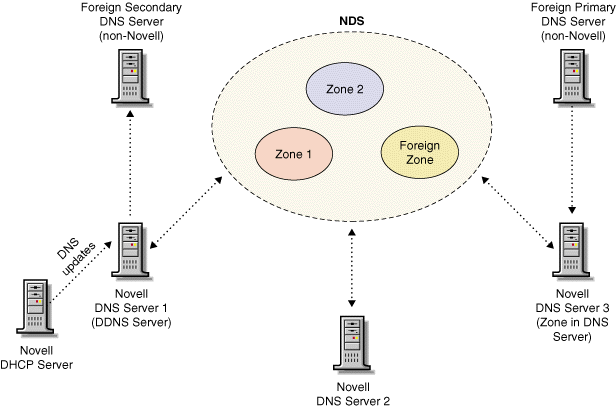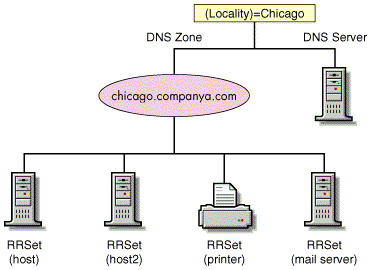Novell Server As a Primary DNS Server

Novell has integrated DNS into NDS by extending the NDS schema and creating new NDS objects to represent zones, RRSets, and DNS name servers. Integrating these new objects into NDS simplifies the administration of DNS, enabling centralized administration and configuration.
A Zone object is an NDS container object that holds RR Set objects, which are leaf objects. A DNS Server object is a leaf object. For detailed information about these objects, refer to New NDS Objects for DNS
By integrating DNS into NDS, Novell has shifted away from the traditional concept of primary or secondary DNS name servers to the concept of a primary or secondary zone.
In traditional DNS, all configuration changes are made on a single primary name server. When changes have been made, the secondary name servers request transfers of the changes from the primary name server. This process is called a zone transfer. The master-slave approach has several disadvantages, the most significant being that all changes must be made at the primary server.
Using the primary and secondary zone concept, Novell's approach allows changes from anywhere in the network through NDS, which is not dependent on one server. Zone data is stored within NDS and is replicated just like any other data in the NDS tree.
Novell's DNS supports the traditional primary-secondary DNS name server approach to moving DNS data in and out of NDS. Although all Novell servers can recognize DNS data after the data is placed in the directory through NDS replication, only one server is required for a zone transfer. The server assigned to perform this function in a secondary zone is called the Zone In DNS server.
In a secondary zone, the Zone In server is responsible for requesting a zone transfer of data from the external primary name server. The Zone In server determines which data has changed for a zone and then makes updates to NDS so that other servers are aware of the changes.
The Designated DNS (DDNS) server is a server identified by the network administrator to perform certain tasks for a primary zone. The DDNS server for a primary zone is the only server in that zone that receives DNS updates from a NetWare 5 DHCP server to perform Dynamic DNS (DDNS) updates. These updates cause additions and deletions of resource records and updates to the zone's serial number.
Novell Server As a Primary DNS Server illustrates a Novell server as the primary DNS name server and primary and secondary zones within NDS. In this example, there are two primary zones. Any of the Novell DNS servers assigned to a zone are able to respond to queries for the zone. For each zone, one server is designated by the administrator to act as the DDNS server. In this example, Server1 is the Designated DNS server for Zone 1 and Server3 is the Zone In server for the secondary zone called Foreign Zone. Server 2 provides DNS services for Zone 1 and Zone 2, but does not perform DDNS updates or zone transfers. Server 3 occasionally requests zone transfers from the foreign server and places the modified zone data into NDS, where any of the Novell servers can respond to queries for it.
Figure 6
Novell Server As a Primary DNS Server
Figure 7 shows a representation of NDS objects within a DNS zone.
Figure 7
DNS Zone
A DNS master file contains resource records that describe a zone. When you use the DNS/DHCP Management Console to build a zone, the DNS objects and their attributes translate into resource records for that zone.
You can use the DNS/DHCP Management Console to import a DNS master file if it conforms to IETF RFCs 1035, 1036, and 1183 and is in BIND master file format. A sample DNS master file is shown in the following example.
$ORIGIN sjf.novell.com. @ soa sjfns.sjf.novell.com. Smith.novell.com ( 1996091454 3600 300 604800 86400 ) ns sjfns.sjf.novell.com. ns ns.novell.com. mx 5 sjf-mx.idz.sjf.novell.com. $ORIGIN sjf.novell.com.sjfns a 123.45.67.89bsmith a 123.45.68.103; End of file